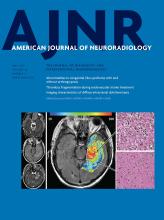Abstract
BACKGROUND AND PURPOSE: Current imaging assessment of high-grade brain tumors relies on the Response Assessment in Neuro-Oncology criteria, which measure gross volume of enhancing and nonenhancing lesions from conventional MRI sequences. These assessments may fail to reliably distinguish tumor and nontumor. This study aimed to classify enhancing and nonenhancing lesion areas into tumor-versus-nontumor components.
MATERIALS AND METHODS: A total of 140 MRI scans obtained from 32 patients with high-grade gliomas and 6 patients with brain metastases were included. Classification of lesion areas was performed using a support vector machine classifier trained on 4 components: enhancing and nonenhancing, tumor and nontumor, based on T1-weighted, FLAIR, and dynamic-contrast-enhancing MRI parameters. Classification results were evaluated by 2-fold cross-validation analysis of the training set and MR spectroscopy. Longitudinal changes of the component volumes were compared with Response Assessment in Neuro-Oncology criteria.
RESULTS: Normalized T1-weighted values, FLAIR, plasma volume, volume transfer constant, and bolus-arrival-time parameters differentiated components. High sensitivity and specificity (100%) were obtained within the enhancing and nonenhancing areas. Longitudinal changes in component volumes correlated with the Response Assessment in Neuro-Oncology criteria in 27 patients; 5 patients (16%) demonstrated an increase in tumor component volumes indicating tumor progression. These changes preceded Response Assessment in Neuro-Oncology assessments by several months. Seven patients treated with bevacizumab showed a shift to an infiltrative pattern of progression.
CONCLUSIONS: This study proposes an automatic classification method: segmented Response Assessment in Neuro-Oncology criteria based on advanced imaging that reliably differentiates tumor and nontumor components in high-grade gliomas. The segmented Response Assessment in Neuro-Oncology criteria may improve therapy-response assessment and provide earlier indication of progression.
ABBREVIATIONS:
- BAT
- bolus arrival time
- DCE
- dynamic contrast-enhanced
- GB
- glioblastoma
- HGG
- high-grade gliomas
- kep
- interstitium-to-plasma rate constant
- Ktrans
- volume transfer constant
- NAWM
- normal-appearing white matter
- nFLAIR
- normalized FLAIR images
- nT1WI+Gd
- normalized T1-weighted images post-contrast agent
- ve
- interstitial volume
- vp
- plasma volume
- RANO
- Response Assessment in Neuro-Oncology
- SPGR
- spoiled gradient-recalled
- sRANO
- segmented RANO
- SVM
- support vector machine
- © 2017 by American Journal of Neuroradiology
Indicates open access to non-subscribers at www.ajnr.org












